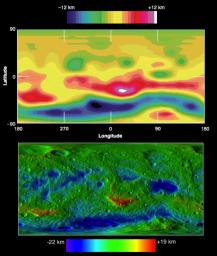
|
Comparing Vesta’s Topography
- Click the image above for a larger view
- Full-Res JPEG (683 x 807) (75.5 kB)
- Full-Res TIFF (683 x 807) (1.7 MB)
Caption:
These two images compare topographic maps of the giant asteroid Vesta as discerned by NASA's Hubble Space Telescope (top) and as seen by NASA's Dawn spacecraft (bottom). Hubble has been in an orbit around Earth, while Dawn orbited Vesta from 2011 to 2012. Although the absolute scale ranges are slightly different in Dawn data, Vesta's relative topography is remarkably consistent between the two data sets. The relative topography in Hubble data varies from 7.5 miles (12 kilometers) below to 7.5 miles (12 kilometers) above a reference ellipsoid shape of 180 by 174 by 142 miles (289 by 280 by 229 kilometers). The relative topography in Dawn data varies from 14 miles (22 kilometers) below to 12 miles (19 kilometers) above a reference ellipsoid shape of 177 by 177 by 142 miles (285 by 285 by 229 kilometers).
Background Info:
The Dawn mission to Vesta and Ceres is managed by NASA's Jet Propulsion Laboratory, a division of the California Institute of Technology in Pasadena, for NASA's Science Mission Directorate, Washington. The University of California, Los Angeles, is responsible for overall Dawn mission science. The Dawn framing cameras were developed and built under the leadership of the Max Planck Institute for Solar System Research, Katlenburg-Lindau, Germany, with significant contributions by DLR German Aerospace Center, Institute of Planetary Research, Berlin, and in coordination with the Institute of Computer and Communication Network Engineering, Braunschweig. The framing camera project is funded by the Max Planck Society, DLR and NASA.
More information about Dawn is online at http://www.nasa.gov/dawn and http://dawn.jpl.nasa.gov .
Cataloging Keywords:
| Name | Value | Additional Values |
|---|---|---|
| Target | 4 Vesta | |
| System | Main Belt | |
| Target Type | Asteroid | |
| Mission | Dawn | Hubble Space Telescope (HST) |
| Instrument Host | Dawn | Hubble Space Telescope |
| Host Type | Orbiter | Space Telescope |
| Instrument | Framing Camera (FC) | |
| Detector | ||
| Extra Keywords | Color | |
| Acquisition Date | ||
| Release Date | 2013-09-27 | |
| Date in Caption | ||
| Image Credit | NASA/ESA/Cornell and NASA/JPL-Caltech/UCLA/MPS/DLR/IDA | |
| Source | photojournal.jpl.nasa.gov/catalog/PIA17466 | |
| Identifier | PIA17466 | |
